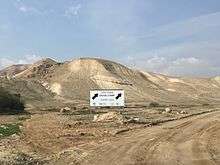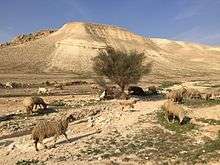Gilgal
Gilgal (Hebrew: גִּלְגָּל Gilgāl; Koinē Greek: Γαλγαλατοκαι Δωδεκαλίθων "Galgalatokai of the Twelve Stones") is the name of one or more places in the Hebrew Bible. Gilgal is mentioned 39 times, in particular in the Book of Joshua, as the place where the Israelites camped after crossing the Jordan River (Joshua 4:19 - 5:12). The Hebrew term Gilgal most likely means "circle of stones".[1] Its name appears in Koine Greek on the Madaba Map.[2]
Places named Gilgal in the Bible
In Joshua 4-5

According to Joshua 4:19, Gilgal is a location "on the eastern border of Jericho" where the Israelites encamped immediately after crossing the Jordan River. There, they erected 12 stones as a memorial to the miraculous stopping of the river when they crossed.[3] Joshua then ordered the Israelites who had been born during the Exodus to be circumcised at this spot. The Bible refers to this place as Givat Ha'aralot, then says that Joshua called the place Gilgal because, in his words, "today I have removed (galoti) the shame of Egypt from upon you."[4]
Some scholars speculate that the circle of 12 stones was the (unnamed) religious sanctuary that was condemned in Amos 4:4 and 5:5 and Hosea 4:15.[5]

Elsewhere in Joshua
"The king of Goyim, of Gilgal" is listed as one of the 31 kings defeated by Joshua.[6] His city is identified by Eusebius with Jaljulia.[7]
"Gilgal" is mentioned as a location on the border between the tribes of Judah and Benjamin, near Ma'ale Adumim.[8]
In Deuteronomy
In the Book of Deuteronomy 11:29-30, Gilgal is a place across from Mount Gerizim and Mount Ebal.
In the Book of Samuel
A place named Gilgal was included in Samuel's annual circuit, and is the location where he offered sacrifices after Saul was anointed as king, and where he renewed Saul's kingship together with the people.[9]
Gilgal is where Samuel hewed King Agag in pieces after Saul refused to obey God and utterly destroy the Amalekites.[10]
On King David's return to Jerusalem after the death of his son Absalom, David traveled to Gilgal. From there he was escorted to Jerusalem by the tribes of Judah and Benjamin.[11]
Again it is possible for this to be yet another "circle of standing stones" [12] (or the same one as mentioned in relation to Elijah and Elisha, as Bethel is on the circuit with Gilgal, and other assumed locations show Gilgal to be far further away than the other two locations), and it is significant that it is treated as a holy place by the biblical text, rather than as a heathen one.
In the Book of Kings
In the Books of Kings, "Gilgal" is mentioned as the home of a company of prophets. The text states that Elijah and Elisha came from Gilgal to Bethel, and then onward to Jericho and to the Jordan,[13] suggesting that the place was in the vicinity of Bethel, and far from Joshua's Gilgal near Jericho.
Since "Gilgal" means a "circle of standing stones", it is quite plausible for there to have been more than one place named Gilgal, and although there are dissenting opinions, it is commonly held to be a different place from the one involved with Joshua; it has been identified with the village Jaljulia, about 11 kilometres (6.8 mi) north of Bethel. It is significant that the Books of Kings treat it as a place of holiness, suggesting that stone circles still had a positive religious value at the time the source text of the passages in question was written, rather than having been condemned as heathen by religious reforms. Another opinion is that it is not different from the Book of Joshua, as it locates it near Bethel as does the Books of Chronicles.
In Hosea
God mentions Gilgal in his rebuke to Israel in the book of Hosea (Hosea 9:15). It is unclear which Gilgal is referred to.
Gilgal as a geographic term
The term gilgal is thought by modern archaeologists to refer to a type of structure, which may then receive additional names, for example "the gilgal by the terebinths of Moreh" (Deuteronomy 11:30) or "the gilgal on the eastern border of Jericho" (Joshua 4:19). Gilgal structures have been found only in the Jordan River valley, and in the Samaritan mountains on the edge of the desert. Pottery discoveries date them to the early Israelite period, with most remains from the 12th-11th centuries BCE. They are located on the lower slopes of a hill, have a footprint-shaped stone outline, and were used for occasional assembly rather than permanent dwelling. These sites are hypothesized to be ritual sites where the early Israelites celebrated holidays together, until worship was centralized. The footprint-shaped outline recalls ancient Egyptian symbolism in which a footprint symbolized ownership. The use of low slopes is in contrast to Canaanite practice, which placed sanctuaries "on every lofty hill" (2 Kings 17:10).[14][15]
References
- Kotter, Wade R. (1990). "Gilgal (Place)". In David Noel Freedman, ed., Anchor Yale Bible Dictionary. Volume 2, p. 1022-1024.
- Piccirillo, Michele (September 21, 1995). "A Centenary to be celebrated". Jordan Times. Franciscan Archaeology Institute. Retrieved 18 January 2019.
- Joshua 4
- Joshua 5:9
- Jewish Encyclopedia, Book of Joshua; Gilgal
- Joshua 12:23
- https://amudanan.co.il/w/P139694
- Joshua 15:7
- 1 Samuel chapters 7 and 11
- 1 Samuel 15:32-33
- 2 Samuel 19:15
- Strong's Concordance: Gilgal
- 2 Kings 2:1-6
- Dror Eydar, In the footsteps of ancient Israelite kings, September 18, 2013
- http://www.news1.co.il/Archive/0024-D-61229-00.html
See also
- Ancient underground quarry, Jordan Valley, possibly associated by the Byzantines with Gilgal and the "twelve stones"
- Yom HaAliyah, Israeli national holiday created to honor the Jewish people carrying the Ark of the Covenant crossing the Jordan River into the Land of Israel at Gilgal as recorded in the Book of Joshua in the Bible.
External links
| Wikisource has the text of the 1911 Encyclopædia Britannica article Gilgal. |
- Dror Eydar, In the footsteps of ancient Israelite kings, September 18, 2013